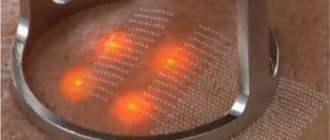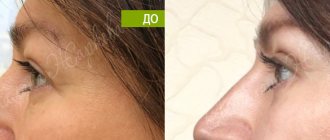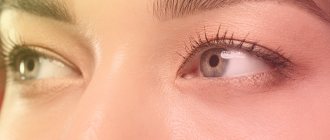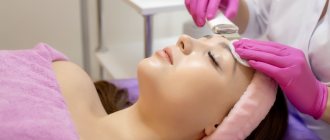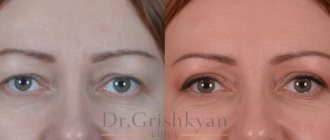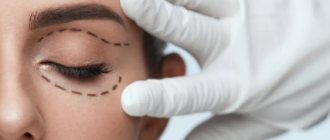Let's look at what problems appear with age in the upper and lower eyelids.
To begin with, we note that swelling in the eye area is not an indication for blepharoplasty; in case of edema, the problems are solved by non-surgical and low-traumatic methods.
Wrinkles around the eyes and in the lower eyelid area can be corrected well with botulinum toxin injections and a number of non-surgical methods.
What problems are usually indicated as indications for non-surgical blepharoplasty:
Upper eyelid ptosis
- Dropping of fat packets, overhang of the brow area
- Loss of skin tone, sagging skin
Lower eyelid problems
- Lower eyelid hernias (bags under the eyes)
- Loss of skin tone, excess skin flap
- Manifestation of the nasolacrimal trough
- Edema formations
In order to understand which problems can be eliminated, and which promises are not entirely honest, you need to understand what eyelid correction without surgery is?
With age, the skin around the eyes loses tone, fat packets seem to “slide” down, and the orbicularis oculi muscle stretches.
The more regularly the patient takes care of the eyelid area, the less intensively these processes will occur. We recommend starting from the age of 30 to carry out preventive procedures aimed at strengthening the skin of the eyelids and the area around the eyes in general.
How does the non-surgical blepharoplasty procedure work?
- Laser resurfacing - fractional rejuvenation DOT
The effect of the SmartXide DOT CO2 laser is to create unique microzones, in place of which intensive cell division and regeneration of the epidermis immediately begins. - NITHYA Collagen Rejuvenation
Injections of safe and pure NITHYA collagen reduce the number of wrinkles around the eyes, improve the quality of the skin and tighten it. - Contour plastic surgery of nasolacrimal grooves
To correct pronounced nasolacrimal grooves, various fillers are used to fill the pronounced grooves and give the area around the eyes a fresh and rested look for a long time. - Lipofilling of the eyelids
Correction of the area around the eyes with the patient’s own fat allows you to replenish the required volume and correct age-related changes. The effect lasts for many years!
Blepharoplasty without surgery using cold plasma
Plasma is the fourth aggregate state of matter that exists under natural conditions in certain situations (plasma is the sun or lightning during a thunderstorm) [1]. Plasma was discovered already in the nineteenth century. It was studied, in particular, by Ernst Werner von Siemens and Michael Faraday [2]. Plasma found widespread use in the 20th century, it is used in street lighting, the spark created by a spark plug is also plasma [1]. It began to be used in medicine about twenty years ago, mainly due to its destructive properties (for example, in electrosurgery) [3].
Only recently have they begun to use the stimulating effect of plasma on living tissues and cells. The use of plasma applied directly to the human body required maintaining its temperature below 40° C to prevent the danger of thermal damage [4].
Such conditions are guaranteed by cold atmospheric pressure plasma, which results from the action of electrical energy on a biologically inactive gas such as argon, nitrogen, helium or air. Almost all electrical energy is spent on exciting electrons, while atoms, ions and gas particles, remaining in a low-excited state, affect other molecules of atmospheric air. As a consequence, this leads to the creation of plasma with biological potential [4]. Medical plasma, or cold plasma as it is often called, is often compared to lightning. This is not a completely accurate comparison, since due to the high energy (high electron density) the plasma that creates lightning is very destructive [5].
Apparatuses currently available in Europe use direct current (for example, an electric arc), alternating current (for example, a dielectric barrier discharge), radio waves, microwaves or plasma flows to create plasma [6]. Plasma can be produced, in particular, directly or indirectly. In the case of directly generated plasma, the discharge gap is located between the electrode of the device and the patient's body. When the device electrode approaches a distance of about 0.5-1 mm, microwave radiation and plasma generation are observed [7, 8].
Figure 1. Device “Plasma BT” (“Plasma BT”)
The operation of the Plasma BT device is based on the use of F-DBD (floating dielectric barrier discharge) technology, protected by four patents, which uses a natural method of producing plasma (from oxygen and nitrogen contained in the air) based on alternating current [9], creating a low-temperature plasma (temperature does not exceed 40° C), which is slightly ionized and has a high content of neutral particles [4]. The “Plasma BT” device (Fig. 1) CE certificate number IT271142..
Figure 2. Patented locking needle
The device has 3 operating modes (Shot, Pulse, Continuous) and 5 levels of output power control.
When operating this device, no grounding is required to protect the patient [10]. The Plasma BT device uses a patented needle with a lock (Fig. 2), which allows the device to be fixed directly to the patient’s body, which improves the accuracy of treatment and the speed of healing.
Practical aspects of upper eyelid blepharoplasty without surgery using the Plasma BT device
The specialist performing this procedure must know the topography of the periorbital region [11], taking into account anthropological differences. For example, there are 4 variants of the Caucasian eye border [13]. The clinician must also be able to distinguish ptosis (drooping of the upper eyelid) from its apparent drooping in the process of dermatochalasis [12].
Before starting the procedure, you should discuss the progress of the procedure and the progress of the healing process with the patient, and also obtain written consent for the procedure. It is also necessary to warn the patient about the need for multiple procedures in the case of large excess skin folds in the eyelid area and prepare him for the lack of improvement or even a slight increase in skin overhang in the case of dermatochalasis with associated eyelid edema.
In Fig. Figures 4 and 5 show the results of treatment of a 42-year-old woman (control pictures were taken 3 weeks after the procedure) using the Plasma BT device with the following settings: Pulse, 40Hz, Level 2.
Rice. 4 Right eyelid: before and 3 weeks after the first procedure.
Rice. 5. Right eyelid: before and 3 weeks after the first procedure.
The patient rated the result of the first procedure as 3 (visible improvement) on a 5-point GAIS (General Aesthetic Improvement Scale) scale and was satisfied with the healing process (swelling decreased after 2 days and small scabs on sublimation points fell off after 3 days). The excess skin was corrected and the asymmetry that existed between the two eyelids before the procedure was reduced. Reduction of the crease opened the upper eyelid by 25% in the right eye and 46% in the left eye, resulting in a 14% widening of the palpebral fissure in both eyes.
Summary
Excess skin in the folds of the eyelids that appears with age is a serious aesthetic problem. Until recently, the only treatment available was surgical removal of excess skin. For some time now, an alternative method has become available, using so-called cold plasma.
Since January this year, the new Plasma BT device (CE certificate number IT271142) using F-DBD technology has been available in Europe, protected by four patents, including a patented locking needle.
“Plasma BT” is a universal device that will meet the expectations of both those doctors who begin “their practice” with cold plasma, and those who expect from the device the ability to individualize therapy by adapting the device settings to the clinical situation, which plasma did not provide devices of the previous generation.
The attachment with a clamp allows for precise sublimation at the treatment points, which can make the first procedures easier, in addition, it will be readily used by experts who will appreciate the convenience and, above all, the speed of working with the attachment and, as a result, a shorter healing time. For adherents of traditional methods with a “steady hand,” the device also includes a classic surgical needle without a lock, which is also used to remove tumors.
The Plasma BT device gives the operator the opportunity to select 5 power levels, available in three operating modes (shot, pulse and continuous). The “shot” mode allows you to accurately determine the time of plasma generation by the device in the range of 0.3–0.6 s; Those who have experience working with the device will appreciate the “pulse” (for example, for a large treatment area) and “continuous” (for example, when removing tumors) modes.
In the clinical case presented in this publication, the Plasma BT device turned out to be an effective and safe device that makes it possible to improve the patient’s quality of life (the excess eyelid crease began to cover the eyelashes on the upper left eyelid and narrow the palpebral fissure) without the need for surgical intervention.
The patient who underwent the procedure appreciated the rapid healing time (the swelling of the eyelids characteristic of this procedure and small scabs at the points of sublimation remained for no more than 3 days) and did not report serious side effects other than the typical ones, such as: a feeling of warmth in the eyelid area immediately after treatment, slight lacrimation observed on the first day, redness of the eyelids, which persisted up to 7 days after the procedure.
Plasma BT is an effective alternative to surgical blepharoplasty in the treatment of excess eyelid folds, which allows individualization of therapy thanks to 5 power levels and 3 operating modes. The use of a patented surgical needle attachment makes the operator more comfortable and ensures precision of the procedure, reducing procedure time and, above all, healing time.
Dr. Krzysztof Jacek Kaczynski
is a graduate of the Faculty of Medicine of the Medical Academy in Gdańsk, Course of Pharmacoeconomics, Marketing and Pharmaceutical Law (graduated with very good results). He graduated with honors from the graduate school of the School of Aesthetic Medicine of the Polish Medical Society, working together with the International Association of Aesthetic Medicine (UIME) in Paris, receiving the title of Doctor of Aesthetic Medicine.
Member of the Polish Society of Aesthetic Medicine and Anti-Aging (Anti-Aging).
Contraindications:
- diabetes;
- diseases of the skin and connective tissue;
- inflammatory processes in the treatment area;
- oncology;
- predisposition to the formation of keloid scars;
- pregnancy and lactation (it is advisable that at least a year has passed after completion of lactation).
Your doctor will tell you more about possible contraindications during your consultation. Before non-surgical blepharoplasty, an in-person consultation is required in all cases.
Deception and inefficiency
So, without surgery with anesthesia, you can remove the manifestation of the tear trough; work with the quality and quantity of skin if there is excess; hide (camouflage) light bags under the eyes in case of a moderate manifestation of the problem.
But first of all, we want to say that every patient is unique ! Only during an in-person examination can a doctor recommend one or another method of correction.
No procedure can radically correct severe sagging of the upper eyelid stage 4 - only a scalpel.
There are a number of dubious proposals to eliminate problems in just one procedure and without a rehabilitation period.
As an example, consider a before/after photo on one of the information sites:
radio lifting is indicated as a procedure . If you try to find the same photographs on other sites , it turns out that the same illustration is given after microcurrents, and after medium peeling, and after patches, although most likely these are the results before/after botulinum therapy. See for yourself:
Do not rush to believe everything that is written on the Internet.
Telephone consultation is always free!
Leave your contact, we will tell you everything and offer a discount!
Send
There are two types of fractional eyelid lifting with laser
The fractional impact can be deep - from 150 to 1,000 microns - and reach the level of the dermis. This procedure is called laser resurfacing.
The superficial impact of a laser from 50 to 150-200 microns in depth is called laser peeling.
The effect of the procedure differs depending on the depth of exposure, which we will discuss further.
Preparing for surgery
Plastic surgery today is rarely considered as a serious surgical intervention. However, laser blepharoplasty should be taken seriously. First of all, you need to find an experienced specialist who can perform surgery with minimal likelihood of complications. Poorly performed blepharoplasty, laser or not, can lead to irreparable consequences and sometimes not only aesthetic ones!
In addition, it is important to understand that such an operation also requires preparation, and after it a number of restrictions apply. Failure to follow the rules can have dire consequences, of which problems with appearance are the most easily remedied.
- Vision problems are a reason for preliminary consultation with an ophthalmologist.
- 2 weeks before the scheduled date of surgery, it is better to stop taking medications if possible. Some medications affect blood clotting and can cause complications during and after surgery.
- When planning the operation, keep in mind that for some time your face will be completely unpresentable. Bruising and swelling will disappear in a few days, but during these days it is better to stay at home.
- After surgery, you will not be able to wear your favorite lenses for up to 1 month. Make sure you have glasses.
- It’s also worth forgetting about the bathhouse and sauna for a month.
Compliance with simple rules is a guarantee of your safety.
